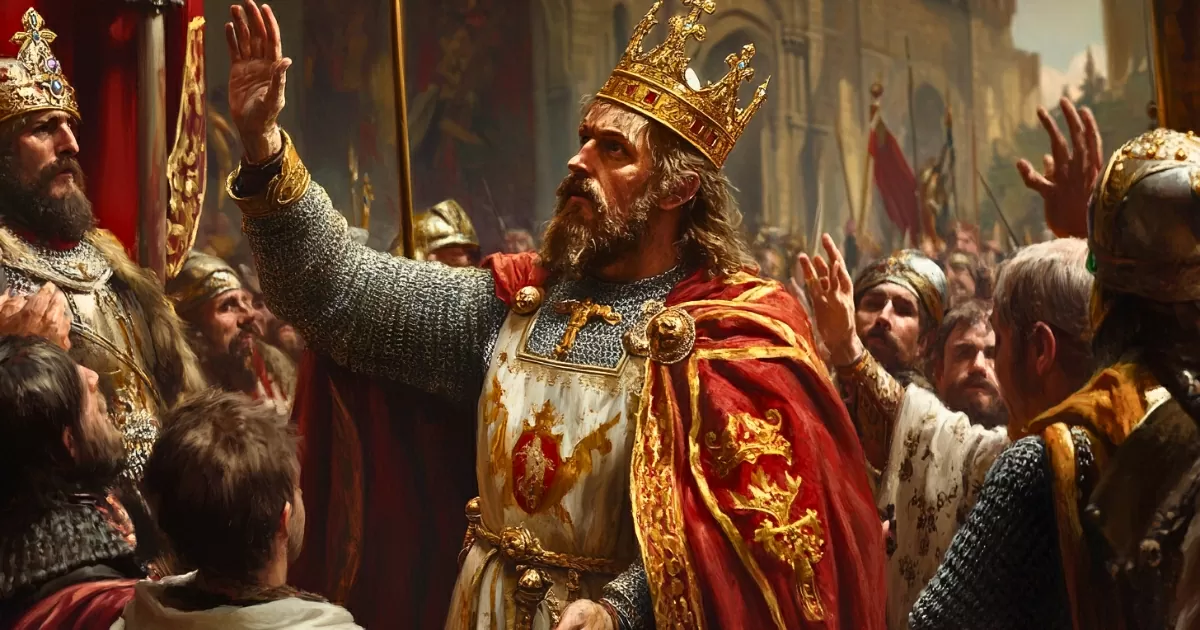Introduction
In the late 8th to early 9th century, a figure emerged who brought a major turning point in Western European history. His name was Charlemagne, also known as Charles the Great. As King of the Franks, crowned Emperor in Rome in 800, Charlemagne laid the foundation for medieval Europe through his vast territory and powerful rule. This article will review Charlemagne’s reign and explore why he is called the “Father of Europe.”
Charlemagne’s Early Life and Rise to Power
Charlemagne was born around 742 in what is now Belgium. His father, Pepin the Short, was the head of the Carolingian dynasty that held real power in the Frankish Kingdom. After Pepin’s death in 768, Charlemagne became co-ruler of the Frankish Kingdom with his brother Carloman. When Carloman died in 771, Charlemagne became sole ruler of the Franks.
Expansion of the Frankish Kingdom
Charlemagne’s reign was a time of territorial expansion for the Frankish Kingdom. He energetically conducted campaigns to surrounding regions, expanding the kingdom’s borders. Notable campaigns include:
- Saxon Wars (772-804): After prolonged fighting, he conquered and Christianized the Saxons.
- Italian Campaign (773-774): Conquered the Lombard Kingdom and became King of Italy.
- Spanish Campaign (778): Advanced into northern Iberia to counter Islamic forces.
- Avar Campaign (791-796): Conquered the Avars in the Danube basin.
These campaigns greatly expanded Charlemagne’s realm to include parts of modern France, Germany, northern Italy, Netherlands, Belgium, Switzerland, and Austria.
Coronation in Rome
One of the most significant events of Charlemagne’s reign was his coronation in Rome on December 25, 800. On this day, in St. Peter’s Basilica, Pope Leo III crowned Charlemagne as “Emperor of the Romans.”
This coronation held great significance. First, it symbolized the revival of the Roman Empire in Western Europe. Charlemagne’s coronation allowed Western Europe to claim equal status with the Eastern Roman Empire (Byzantine Empire). However, the Eastern Empire did not recognize Charlemagne’s imperial title, which became a source of tension between East and West.
Moreover, the Pope crowning Charlemagne demonstrated the close relationship between secular power and the Church. This would greatly influence the relationship between church and state in medieval Europe. This event also laid the groundwork for the later Holy Roman Empire.
Establishment of Governance Systems
To efficiently rule his vast territory, Charlemagne established various systems:
- Count system: Created “counties” as local administrative units, appointing counts to govern each.
- Missi dominici: Royal representatives who traveled to supervise local governance.
- Military service system: Developed a system of granting land to vassals in exchange for military service. This influenced the later development of feudalism, though full feudalism was not established until after Charlemagne’s death, gradually evolving from the 9th to 10th centuries.
- Monetary unification: Introduced the silver denarius coin to stabilize the economy.
- Legal system development: Codified local customary laws, creating the basis for a unified legal system.
These systems would greatly influence governance in medieval Europe.
The Carolingian Renaissance
Charlemagne’s reign was also a period of great cultural development. The cultural revival of this period is called the “Carolingian Renaissance.” However, this was not a complete revival of ancient Roman culture, but rather a cultural revival movement within the framework of Christian culture. Key features include:
- Education promotion: Established palace schools to educate clergy and officials.
- Classical revival: Reevaluated ancient Roman literature and learning, encouraging collection and reproduction of manuscripts.
- Artistic development: New styles emerged in architecture, sculpture, and manuscript illumination.
- Language unification: Promoted the use of Latin, establishing it as a common language.
- Scholarly development: New works emerged in theology, history, grammar, and other fields.
The Carolingian Renaissance formed the cultural foundation of medieval Europe and influenced the later Renaissance.
Charlemagne’s Legacy
After Charlemagne’s death in 814, his great empire gradually fragmented. Notably, the Treaty of Verdun in 843 divided Charlemagne’s empire into three parts, forming the prototypes of later France, Germany, and Italy. However, the impact of Charlemagne’s reign on Europe was immeasurable:
- Political legacy: Charlemagne’s empire became the foundation for the later Holy Roman Empire.
- Cultural legacy: The Carolingian Renaissance contributed to forming the cultural identity of medieval Europe.
- Religious legacy: The spread of Christianity and organization of the Church became the religious foundation of medieval Europe.
- Legal legacy: Charlemagne’s legal system influenced the development of later European law.
- Economic legacy: The unified monetary system and trade networks laid the foundation for medieval European economic development.
These legacies led to Charlemagne being called the “Father of Europe.”
Conclusion
Charlemagne’s reign was a crucial period in the formation of medieval Europe. His military conquests, political unification, and cultural promotion deeply influenced subsequent European history. His coronation in Rome in 800 symbolized the revival of the Roman Empire in Western Europe and was a significant event demonstrating the relationship between secular power and the Church in medieval Europe. The Carolingian Renaissance, as a cultural revival movement within the framework of Christian culture, greatly contributed to forming the cultural identity of medieval Europe.
Charlemagne’s legacy spans politics, culture, religion, law, and economics. The institutions and culture formed under his reign became the foundation of medieval Europe and continue to influence modern Europe.
Charlemagne’s evaluation as the “Father of Europe” is based on his laying the groundwork for the political and cultural integration of medieval Europe. His reign marked a crucial turning point in the transition from late antiquity to the medieval period, with immeasurable influence. Understanding Charlemagne’s legacy is essential for comprehending the formation of medieval Europe and provides an important perspective for understanding modern Europe.


